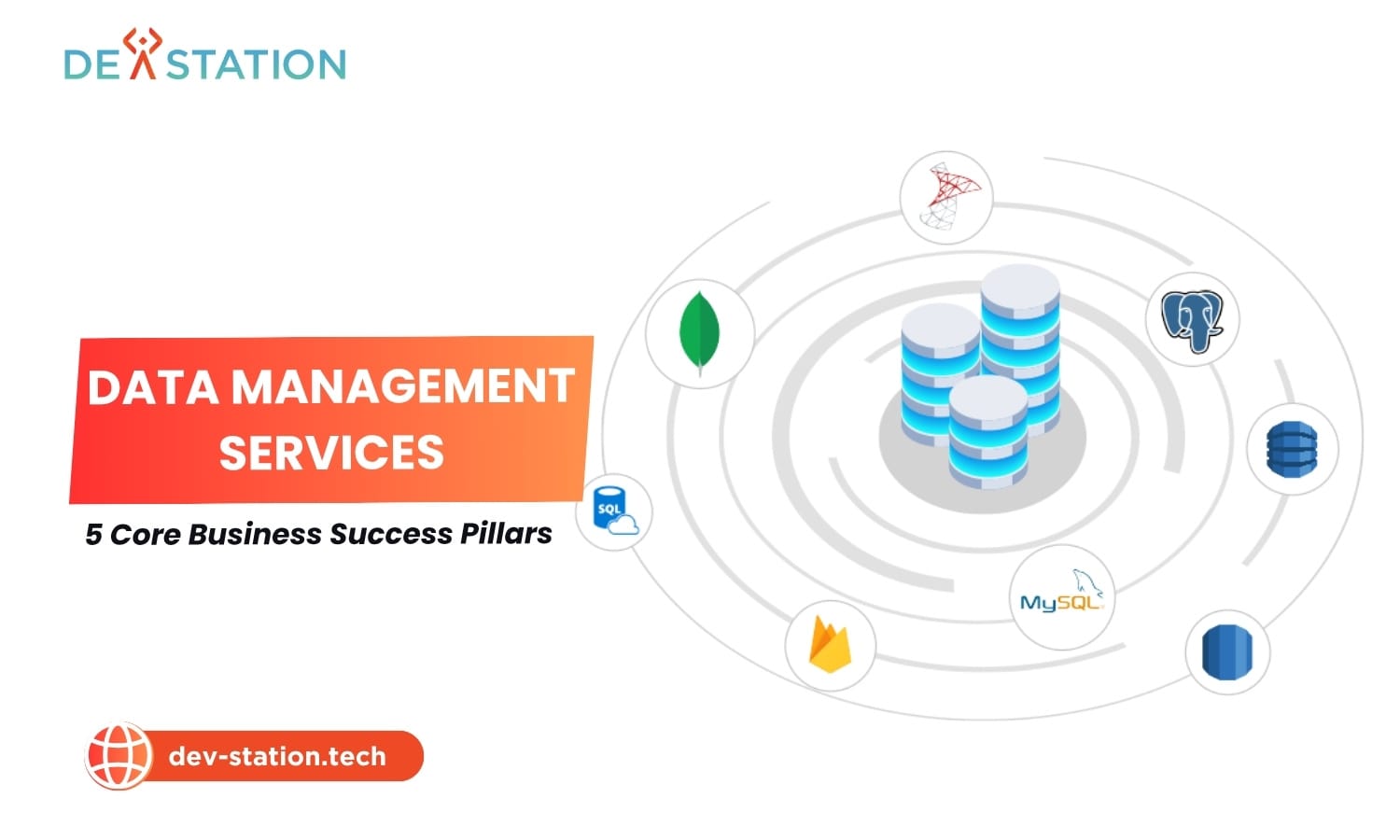Data management services provide a structured framework to organize, secure, and leverage your company’s most valuable asset. At dev-station.tech, we deliver robust solutions to transform your raw information into a strategic advantage, ensuring your data is accurate, accessible, and ready for growth. Explore our enterprise data solutions and information governance framework.
Contents
ToggleWhat Are the 5 Core Data Management Services Your Business Needs?
To succeed in a data-driven world, businesses must implement five core data management services: Master Data Management and Governance, Data Quality and Cleansing, Data Storage and Warehousing, Data Integration, and Data Security and Compliance.
In today’s economy, data is more than just information; it is the central asset driving strategic decisions and competitive advantage. The global enterprise data management market is projected to grow at a compound annual growth rate (CAGR) of 12.4% from 2025 to 2030, highlighting its critical importance. Yet, many organizations struggle to harness its full potential due to overwhelming volume and complexity. Professional data management outsourcing companies offer specialized expertise to navigate this landscape. Here, Dev Station Technology outlines the five essential pillars of information management services that are foundational for organizational success.
1. What is Master Data Management (MDM) and Data Governance?
This service establishes a single, authoritative source of truth for critical data entities like customers, products, and suppliers, governed by a clear framework of policies and accountabilities.
Master Data Management (MDM) is the discipline of creating one consistent, trusted view of your core business entities. According to Gartner, MDM is a technology-enabled business discipline where business and IT collaborate to ensure uniformity, accuracy, and accountability for an enterprise’s shared master data. This prevents data silos where different departments have conflicting versions of the same information. A core component of this is building a comprehensive data strategy and consulting framework.
Data Governance complements MDM by providing the necessary structure. Gartner defines data governance as the framework of decision rights and accountabilities for information-related processes. It answers questions like: Who owns the data? Who can access it? How is its quality maintained? Implementing a robust data governance framework is a foundational best practice for any successful data initiative.
- Business Benefit: By creating a trusted golden record for each customer and product, companies can significantly improve customer experience and operational efficiency. For example, a retailer with strong MDM can ensure a customer’s online profile and in-store loyalty account are perfectly synced, offering a seamless omnichannel experience.
- Financial Impact: Organizations with mature MDM programs report faster time-to-market for new products and services and reduced compliance costs due to fewer data-related errors.
2. Why Are Data Quality and Cleansing Services Essential?
These services ensure that your data is accurate, complete, and consistent through processes of validation, standardization, and enrichment, making it reliable for decision-making.
Poor data quality is a silent killer of business performance. Research from Gartner indicates that bad data costs companies an average of $12.9 million annually. Another report estimates this cost to be as high as $3.1 trillion per year for U.S. businesses alone. These costs arise from operational inefficiencies, flawed analytics, and missed revenue opportunities. Data quality services are designed to mitigate these risks by systematically profiling, cleansing, and monitoring data.
The process involves several key steps:
- Data Profiling: Analyzing data sources to understand their structure, content, and interrelationships, identifying potential quality issues.
- Data Cleansing: Correcting or removing inaccurate, incomplete, or duplicate data. Studies show that duplicate entries can cause up to 70% of data quality problems.
- Data Enrichment: Augmenting internal data with information from external sources to create a more complete and valuable dataset.
Implementing automated tools to monitor and cleanse data is a modern best practice that shifts organizations from reactive to proactive data quality management.
3. How Do Data Storage, Warehousing, and Architecture Services Work?
This service involves designing and implementing the optimal infrastructure for storing and accessing your data, whether through on-premise databases, cloud data lakes, or modern data warehouses.
As global data creation is expected to surpass 180 zettabytes by 2025, choosing the right storage and architecture is critical. A professional database management company can design a system that fits your specific needs. Modern data architecture has moved beyond traditional on-premise databases. Today, the leading trend is the adoption of cloud data warehousing services. Platforms like Amazon Redshift, Google BigQuery, and Snowflake offer unparalleled scalability, flexibility, and cost-efficiency.
The key components of this service include:
| Component | Description | Primary Benefit |
|---|---|---|
| Data Warehouse | A central repository of integrated data from one or more disparate sources, structured for querying and analysis. | Enables powerful business intelligence services. |
| Data Lake | A vast pool of raw data in its native format, including structured, semi-structured, and unstructured data. | Flexibility for data science and machine learning. |
| Data Architecture | The blueprint for how data is collected, stored, processed, and integrated across the organization. | Ensures scalability, security, and efficiency. |
4. What Are Data Integration and ETL/ELT Services?
These are the processes and tools used to move data from various sources into a centralized system like a data warehouse, ensuring a unified view for analysis.
Data integration is the backbone of any analytics initiative, as it breaks down data silos. Without it, your business is operating on an incomplete picture. The two primary methods for this are ETL (Extract, Transform, Load) and ELT (Extract, Load, Transform). While traditional systems relied on ETL, the market is rapidly shifting toward ELT, driven by the power of modern cloud data warehouses.
- ETL (Extract, Transform, Load): Data is extracted from sources, transformed in a separate processing server, and then loaded into the target warehouse. This approach is well-suited for structured data and compliance-heavy scenarios.
- ELT (Extract, Load, Transform): Raw data is loaded directly into the cloud data warehouse, and transformations are performed in-warehouse using its powerful processing engine. This is faster, more flexible, and ideal for handling diverse big data services and unstructured data types.
The global market for data pipeline tools is projected to grow at a 26.8% CAGR, far outpacing traditional methods, indicating a strong industry preference for modern integration approaches like ELT. Efficient integration is fundamental to managing the future of data.
5. Why is Data Security and Compliance a Core Service?
This service implements the policies, tools, and procedures required to protect data from unauthorized access and ensure it complies with regulations like GDPR, CCPA, and HIPAA.
Data security is not optional. The cost of a single data breach can be devastating, with IBM’s 2025 report finding the average cost for U.S. companies has reached an all-time high of $10.22 million. Healthcare remains the most heavily impacted industry, where breaches are the most expensive. These figures underscore the financial imperative of robust data security.
Key security practices include:
- Access Control: Implementing role-based access control (RBAC) to ensure employees can only view data necessary for their roles.
- Encryption: Encrypting data both at rest (in storage) and in transit (across networks) to protect it from interception.
- Compliance Management: Ensuring all data handling processes adhere to relevant regulations, which is especially critical when dealing with the big data challenges in healthcare.
- Monitoring and Auditing: Continuously monitoring for threats and maintaining audit logs to track data access and changes.
How Do You Choose the Right Data Management Partner?
Selecting the right partner involves evaluating their industry expertise, technical capabilities, alignment with your business goals, and their approach to security and governance.
The data analytics outsourcing market is projected to reach USD 131.32 Billion by 2033, growing at a CAGR of 25.06%. This growth reflects the increasing trend of companies seeking specialized expertise. When outsourcing these critical it data services, you are not just hiring a vendor; you are choosing a strategic partner. Forrester research emphasizes matching your needs to a provider’s core competencies and regional presence. A partner in data service management should act as an extension of your team.
Consider the following criteria when selecting from data management companies:
- Define Your Objectives: Clearly outline what you want to achieve. Are you focused on improving data quality, building a new data warehouse, or developing a comprehensive governance plan? This will help you find a partner with the right specialization.
- Evaluate Industry Experience: A partner who understands the nuances and regulatory requirements of your industry, such as finance or healthcare, can provide significantly more value.
- Assess Technical Expertise: Inquire about their proficiency with modern tools and architectures. Do they have certified experts in cloud platforms and data integration tools?
- Review Their Process: A reputable partner will have a transparent and structured process for project management, communication, and delivery. Ask for case studies and client references.
- Prioritize Security and Governance: Ensure the provider has robust security protocols and a deep understanding of master data management and governance principles.
At Dev Station Technology, we pride ourselves on a collaborative, transparent approach that aligns with your strategic business goals. We combine technical excellence with deep industry knowledge to deliver data management services that drive tangible results.
To learn more about how a structured approach can transform your business, we invite you to explore our services at dev-station.tech or contact our team of experts directly at sale@dev-station.tech for a personalized consultation.





